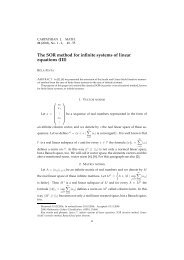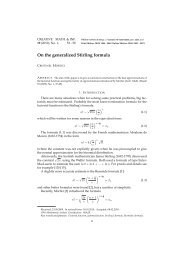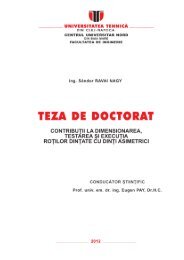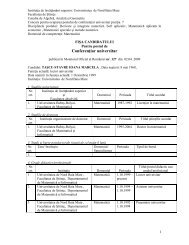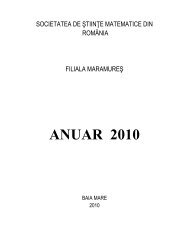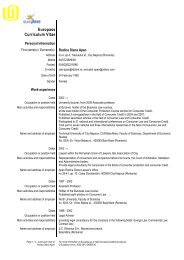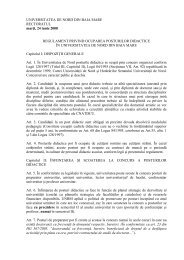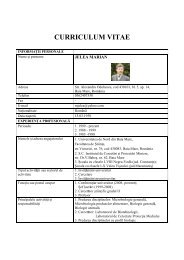Vol 3 (1) 2011 - UBM :: Departamentul de Chimie-Biologie
Vol 3 (1) 2011 - UBM :: Departamentul de Chimie-Biologie
Vol 3 (1) 2011 - UBM :: Departamentul de Chimie-Biologie
Create successful ePaper yourself
Turn your PDF publications into a flip-book with our unique Google optimized e-Paper software.
M. Ayaz Javed, M. Na<strong>de</strong>em, Development of probiotics ice cream in Pakistan from buffalo milk by using<br />
B. bifidum and L. acidophilus<br />
mL). All these treatments were compared<br />
with a control T 0 which did not contain any<br />
probiotic culture. Each treatment was<br />
replicated 3 times. The mix was heated to<br />
80°C, homogenized in a clean and sanitized<br />
double stage homogenizer (APV) at 100<br />
kg/cm 2 and 35 kg/cm 2 pressure in the first<br />
and second stage respectively. Probiotic Ice<br />
cream was manufactured in the pilot plant of<br />
the Research and Development Department,<br />
Unilever Walls Ice Cream Factory Lahore,<br />
Pakistan. One gm freeze dried culture for L.<br />
acidophilus contained = 8.4 x 10 9 cfu and<br />
one gm freeze dried culture for B.bifidum<br />
contained = 7.5 x 10 9 cfu. From these<br />
gui<strong>de</strong>lines the quantities of probiotics<br />
cultures were calculated as 1000 mg= 10 9,<br />
100 mg= 10 8 , 10 mg= 107 and 1mg= 10 6 .<br />
The composition of basic formulation<br />
(control) comprised 8% milk fat, 10%<br />
MSNF, 10% sucrose, 4% liquid glucose,<br />
0.25% sodium alginate and 0.25% glycerol<br />
monostearate. The experiments involved<br />
making of 10 types of ice cream i.e., T 1 to T 9<br />
along with control T 0 .<br />
2.4. Inoculation of probiotic culture in ice<br />
cream mix<br />
Ice cream mix was divi<strong>de</strong>d into ten<br />
equal parts. Each part was inoculated by<br />
probiotic culture according to the<br />
experimental <strong>de</strong>sign except for control. Each<br />
sample was mixed well and kept for<br />
fermentation for two hours at 41°C. Mix was<br />
cooled at 4°C; vanilla flavor was ad<strong>de</strong>d in it<br />
and aged for 24 hours followed by freezing<br />
and har<strong>de</strong>ning. It was packed manually in 1<br />
liter plastic tubs and was first frozen at -5°C<br />
at -18 °C.<br />
2.5. Analysis<br />
Ice cream samples were stored at -18<br />
°C ± 2°C and were analyzed for physical,<br />
chemical, microbiological and sensory<br />
evaluation. Melting resistance, overrun and<br />
viscosity was <strong>de</strong>termined by using the<br />
procedures as <strong>de</strong>scribed by Upadhyay et al.<br />
[8]. pH, acidiy, fat, protein, total solids<br />
content was <strong>de</strong>termined following the<br />
respective procedures as prescribed in<br />
AOAC [9]. Reinforced Clostridial Agar<br />
(RCA) (Oxoid) was used as a media to<br />
enumerate L. acidophilus and B. bfidum<br />
(Ming, 1989) in probiotic ice cream samples.<br />
RCA media was prepared by following the<br />
instructions of manufacturer (Oxoid). Frozen<br />
fermented ice cream was thawed and then<br />
diluted in autoclaved 0.85% saline. With the<br />
help of micropipette ,one-tenth milliliter of<br />
each dilution was placed on the centre of<br />
solidify RCA plates and spread evenly over<br />
the surface by means of a sterilized bentglass-rod<br />
The plates were then incubated in<br />
an anaerobic environment (Anaerogas Pack<br />
Himedia ref LE 002A-5NO) at 37ºC for 48<br />
hours. The total numbers of L. acidophilus<br />
and B. bifidum were <strong>de</strong>termined based on<br />
their colony morphology when grown on<br />
RCA. L. acidophilus produced pinpointsized<br />
colonies, but B. bifidum produced<br />
large colonies.<br />
2.6. Sensory evaluation<br />
Ice cream samples prepared from all<br />
the treatments of probiotic cultures together<br />
with regular (control) were subjected to<br />
sensory evaluation by trained taste panel of<br />
five judges. Evaluation was done by using<br />
nine (9) point hedonic scale on a sensory<br />
evaluation Performa for following<br />
parameters; color, thickness, flavor, taste<br />
and overall acceptability. All the samples<br />
were co<strong>de</strong>d with three digit random number<br />
and all or<strong>de</strong>rs of serving were completely<br />
randomized [10].<br />
2.7. Statistical analysis<br />
The data was obtained by using<br />
Completely Randomized Design (CRD) and<br />
outcome of the analysis was analyzed<br />
through two way analysis of variance un<strong>de</strong>r<br />
factorial arrangement to find out the effect of<br />
treatment and effect of storage time on<br />
probiotics ice cream by following the<br />
14



